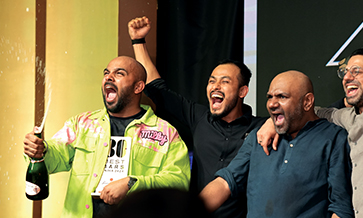When we look at the performance of the Global beverage alcohol market and volume change in the top 20 markets – and look at India in that context – what we are seeing here is that in the period 2021-22, India showed the fifth-largest market growth in volume terms. And the expectation to 2027 is that it will be one of the better performing countries.
Overall for spirits, India is the number one market in the world for whiskey, brandy and rum in terms of absolute volumes. It is number six for vodka, behind four Eastern European markets and the US. It is about number 11 for beer; it comes quite a lot lower down in wine. But India is amongst the larger producer nations.
There were 2 years of recovery for beer because of the timings of the lockdowns and I have a rather modest forecast of 4% or 5%’ but it’s the number one market in this period for growth. It’s number two, behind Thailand, in terms of the absolute volume growth and these forecasts can certainly be beaten.
We’ve got a pretty modest forecast – again about 5-6% – but India is in the top five, even the top two, but pretty much every category going forward and in present.
Market penetration
So let us look at some figures sourced from the National Family Health Survey 2021 of the percentage of individuals over the age of 15 who drink alcohol. 21% of possible male drinkers drink and that’s about just under 100 million. For women, it’s a fraction over 1%. That’s 5 million!
So, out of that total population of 900 million that could drink only around 105 million do drink. Increasing that penetration is going to be a big part of increasing the size of the beverage alcohol market.
If we look at the middle class – defined as households earning around US$ 40,000 a year – between 2016 and 2021, about 83 million citizens were added to the middle class based on the income criterion. It is forecasted in the next decade there will be another 200 million middle-class individuals in India.
These are very important because these are men and women with disposable incomes. The working population is key to the kind of buoyancy of the consumer market. In 2010, there were about 790 million Indian working-age population consumers. There will be more than 1.1 billion by 2050.
These are individuals in the prime of their lives, experimental and they’ve got the money and this presents a massive market opportunity. What you’ve seen so far is largely from our country reports.
The India country report offers both a BEV track and a consumer tracker that also tracks a lot of different attitudinal behaviours. Now this one is by generation split, Gen Z, Millennials, Gen X and Boomers.
Generation gaps
Gen Z are under-average consumers of Indian whiskey and Scotch. So that’s not going to massively affect the composition of the market immediately. But over time there will be not necessarily a lessening demand for whiskey but certainly an increase in demand for other categories. If you look at the Millennials there’s a higher average among Indian drinkers.
So every category is reliant on the consumer behaviour of Millennials and they are driving this. Now what’s interesting about that is when Gen Z gets to the age of Millennials, they may well behave in similar ways.
You can also see that Gen X and Boomers are the real drivers of Scotch and Indian whiskey consumption, but they’re less experimental with the other categories. Perhaps wine is slightly interesting, but certainly for boomers they don’t drink much apart from gin.
Above average consumption of fresh cocktails amongst younger consumers. Where is this below average? Older consumers. So that’s a real trend, something to be mindful of. But this survey includes a lot more interesting stuff: I have picked only a few little trends!
Another one’s on no and low alcohol. So there are three parameters here. The first is brand loyalty. Both in China and India the Boomers are loyal consumers. Every other generation is to a greater or lesser degree more experimental. And the interesting difference, if you look between China and India, is the Millennials.
Local vs imported
Then we look at local versus imported. Now you can see here that everything amongst Chinese consumers, the preference is towards the local, whereas amongst Indian consumers it is towards imported.
There are several reasons. One is the composition of the market. In China, a lot of it is local brands – it’s local rice-based wines, grape-based wines, Baiju, etc.
Whereas India is a market that already has an international aspect with India-made foreign liquor. You don’t have to convert consumers to whiskey, to gin, to rum, to brandy. They already drink these. You just take them up from the cheaper products to the more expensive products.
This doesn’t mean that local consumers don’t have an affinity with local brands in India. But equally, they’d like to discover imported brands. And increasingly, they’re recognizing that where 20 years ago, Indian brands might be.
You can see that Boomers are much less inclined to go out now than perhaps they were before; but certainly less than younger generations. So the at-home consumption, which is a real feature of lockdowns, is kind of concentrated in the hands of the Boomer generation.
We’ve got five countries here, as well as a global average. The five countries are the US, UK, Germany, China and India. I’m more interested in no and low alcohol. The key here is that Indians are the most interested in products that point to moderation.
Price points
Another key aspect is going to be price because you are not necessarily competing with a no-alcohol product or against a 5% beer. You’re competing against Coke, or a Pepsi on price. And if it’s a de-alcoholised product, the odds are probably going to be higher than for the alcoholised product.
The innovation in entrepreneurship within the Indian psyche that’s going to really help push things including new products, new ideas, regional, local, etc. Retail is very important, particularly for female consumers. It used to be a horrible experience going to buy a bottle of whiskey, but now it’s almost like a global travel retail experience.
I don’t necessarily think e-commerce is going to take off very soon because of the bureaucratic elements. But actually, it already exists. It’s called Quick Commerce.
You guys phone up the local retailer, the local liquor shop, and you get somebody to come and deliver on a bike within 10 minutes!
For the full presentation, visit Brews&Spirits Expo on YouTube.













